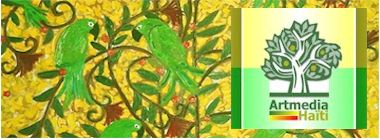
|
|
|
| --> Category: Haitian Art - Testimonials |
| |
|
|
| In no other country has a school of self-taught painters and sculptors reigned supreme, renewing itself year after year. - Seldon Rodman |
 The Haitian canvas is one of the most faithful recorders of both radiant humor and the idyllic melancholy of Haiti's many faces. The painters' oeuvre remains among the most consistent notations of our dreams, ideal, culture and history. Just a cursory glimpse at some of the paintings in the Demme collection gives you a flavor of both the universal and the particularly Haitian themes addressed by the artists. In my interviews and casual conversations with some of Haiti's wonderful and talented painters, I have come to realize that many of them wish to accomplish what some of the best work does. They want to portray our heritage and religion. They want to recreate the faces and events of history, both the well known and the unknown. They want to use the beauty of the land and current events to allow them to tell their own truths. Edwidge Danticat  In the 1940s and 1950s Haitian art sprang, like Athena from the head of Zeus, fully grown and fully armed. Dr. Lisa E. Farrington  In 1943, Dewitt Peters arrived in Haiti and became the prime mover behind the Centre d'Art. This was the spark that set off the powder that detonated this formidable explosion of Haitian Art. Gerald Bloncourt Art Historian  ...a study of Haiti offers significant and valuable insights on an understanding of a people whose history has been one of struggle and survival, and whose art speaks of brilliance, creativity and wit. That a study can express the vitality of a people through its art, history, music and dance traditions, and religious belief is testament to the significance of the arts and humanities in our lives. Through their interdisciplinary exploration, we may develop an enhanced understanding of the world, a respect for others, and ultimately, a better sense of self. Essential educational opportunities like these inspire young people to think and even dream, to expand their sense of history, geography and tradition and culture across time and place. There is no greater goal. Sacred Art of Haitian Voudou  Haitian Art began to flourish with the opening of the Centre des Arts in Port-au-Prince in 1944. With this new facility an environment was created that allowed talented artists to develop their artistic skills while expressing themselves in their own unique style. The Centre provided instruction as well as a space to exhibit the art produced by its students. The early Haitian painters were completely untrained in formal art techniques and took their inspiration from everyday Haitian life as well as history, religion and Voodoo. Even after artists were trained in traditional techniques and versed in master painters from around the world they stayed with the subject matter that had served their forbears. Haitian paintings are bursting with spontaneity, vibrant colours and the simple richness of Haitian life. The Stone Walrus  Haitian Art and culture has been described as an extraordinary blend of African, French, Spanish, and Indian influence, reflecting the unique multicultural mix of this Caribbean island. Yet those who have visited Haiti would see it as an expression of the Haitian soul. While some Haitian art may lack the polish found in more developed countries, it makes up for this with a deep and engaging representation of humanity. The Haitian artist finds holiness in the ordinary subjects of every day life. A crowded and colorful village market, the lined face of an elderly man, a mother embracing her child with tenderness, or women gathered at the river to wash their laundry, these are simple, soulful images commonly found in Haitian art. It is this soulfulness that attracts so many to admire and collect this remarkable art. Jane Mason Saint Joseph Worker Foundation  Haiti has to be one of the more artistic countries I've ever been to. Just about every public establishment, from a tiny corner restaurant to an elegant mountain hotel, proudly displays native Haitian art Jay Fitzgerald  The country has many celebrated painters, chief among them Hector Hippolyte, Lafortune Félix and Prefete Duffaut. Though often described as -naive-, Haitian painting has a rich visual and thematic vocabulary, often rendered in vibrant colors and sensual, organic forms. The country has also been the subject of novels by well-known foreign writers, notably Zora Neale Hurston's Tell My Horse: Voodoo and Life in Haiti and Jamaica, and Graham Greene's The Comedians, a send up of the early Duvalier years. Haitian writers include Jean Price Mars and René Depestre. Lonely Planet  According to Joseph Campbell, an authority on Haitian art, -Haitians are unique and original in their arts-. He said art forms created for use in religious rituals are -incredibly powerful works- in Haiti. -In the case of voodoo, the traditional banners or flags are no exception as they synthesize the symbolism embodied in African tradition, Roman Catholicism, Masonic symbols and Arawak Indian influences,- he said. Campbell asserted that the -world without spirits is a wasteland-, and Haiti remains a wellspring of creativity and imagination despite the hardships and political trauma suffered by the country. Chicago State University  Menacing Zombies rising up as the undead; dark jungle Voodoo rituals performed against unsuspecting white intruders--curses, cannibals, and blood sacrifice are the images of Haitian religion and the early cultures of the Caribbean that have been emblazoned into the popular American consciousness by Hollywood movie makers since the 1930s. But is our mistaken and distorted view of Voodoo merely the product of the fertile imagination of pop culture storytellers, or a not-so-subtle proliferation of accepted racist and dehumanizing attitudes toward blacks by the European conquerors and occupiers of the Caribbean? Voodoo evolved as the predominant religion of the Haitian people by bringing together a number of traditions that followed enslaved Africans to the New World. But it was the dehumanizing, tyrannical conditions black people faced in the New World and their exposure to European traditions and practices of Roman Catholicism that defined Voodoo beliefs and rituals. San Diego Museum of Man  From its beginning in the mid-forties with the discovery of Hector Hyppolite and Philome Obin, to its fourth flowering in 1987 with the painters of Saint-Soleil becoming dominant, Haitian art has been consistently surprising: a wonder of the world. In no other country has a school of self-taught painters and sculptors reigned supreme, renewing itself year after year. Not even in Africa have black artists created so many unforgettable images to haunt and revivfy the tired iconography of the West. How to explain the paradox that an art of joy originated and sustains itself in the poorest nation of the Western Hemisphere? A blend of African and French cultures, inspired by both the Vodou and Christian religions, Haitian life has a unique quality, timeless yet electric. Close to nature, close to his family, close to his gods, the Haitian farmer still leads a life little influenced by the fashions and the inventions of the twentieth century. Some of Haiti's greatest artists, Hector Hyppolite, Andre Pierre, and Lafortune Felix were first houngans (vodou priests). All of the Saint-Soleil artists, first hailed by Andre Malraux in 1977, say they are in constant contact with the loas (African Spirits), as was their progenitor, Robert St. Brice. The dark side of the religion, so well captured by the macabre images of Enguerrand Gourgue and Edgar Jean-Baptiste, is a force every Haitian must reckon with. The simplicity of everyday life, transformed into poetry by Philome Obin and the Cap-Haitian school, gives to each Haitian a sense of place in this world just as the Vodou religion assures him a place in the cosmos. Ongoing life that neglects neither the body nor the spirit... that is the joy of Haitian art. Selden Rodman Where Art is Joy, Haitian art: the first forty years  African Art has produced ramifications beyond the shores of the continent and the oceans. Connected only by the power of the same creative spirit, the people of Haiti, through its born carvers and self-taught painters have produced what's known as -the beautiful and festive- art of Haiti. Haitian Art is very well known and appreciated in different points of the globe for its marvelous paintings and wonderful carvings. The Afro-Caribbean Showcase  From the rhythms of the countryside to the brilliant palettes of Port-au-Prince and the lilting cadence of Creole, Haitian music and art have always been rich, culturally distinct phenomena. City Arts  We Like Haitian Art. We confess to knowing little about Haitian art, but we know what we like, and Haitian art makes the grade. Its distinctive style originated when unschooled artists created a school of their own. The look is unmistakable, a sort of visual equivalent of the magical realism of Mexican and South American literature. More than that, There's a unique clarity in the light and bold colors. Claude Dambreville's studies in female form seem to glide off the canvas, and animal paintings hint at but never give in to anthropomorphism. Every inch of canvas is crowded, yet There's no mistaking the focal point. Yes. We like Haitian art very much. Netsurf  Botticelli's Birth of Venus (1480), cited so often as an example of the Western ideal of female beauty, invites discussion as to how these ideals vary from culture to culture. Another nude female from the Haitian Renaissance of the 1940s reveals a different ideal. Hector Hyppolyte's painting of the goddess Erzulie offers an example of a more fulsome, darker-skinned, voluptuous beauty whose taste for luxury and sumptuous surroundings is, in many ways, antithetical to Botticelli's vision. Lisa Farrington  Although Haiti has had many difficulties throughout its history, its art will always survive. M. Ona |
|
|
||
 Designed and Maintained by InterMedia, The Internet Communications Network of Haiti™  ArtMediaHaïti Suite 200 - Angles des Rues Grégoire et Chavannes P.O. Box 16042 - Pétionville, Haiti Telephone: (509) 511-1314, 557-5290, 403-1130, 401-1626 - Fax: (626) 608-3594 http://www.artmediahaiti.com [email protected] |
||
| Service | Contact | Cart-Panier | Home-Accueil | ||
| © All Rights Reserved-Copyright©2001-2002 by ArtMedia Haiti-Port-au-Prince, Haiti | ||
